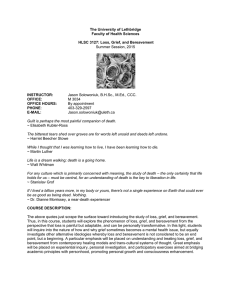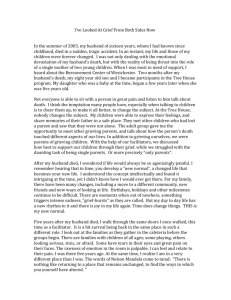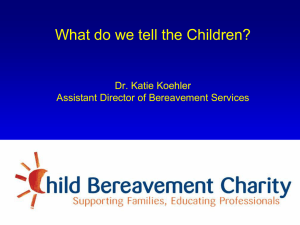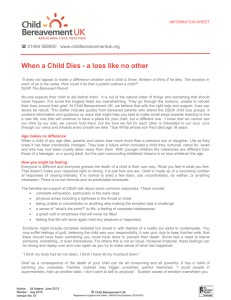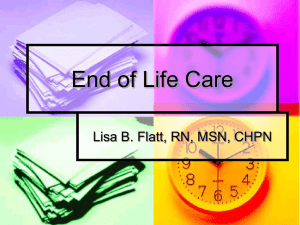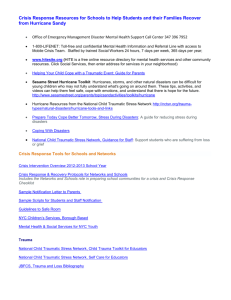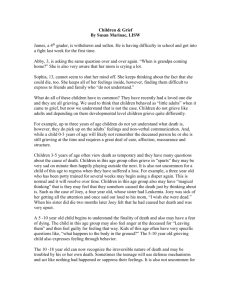HLSC 3127 Loss-Grief Fall 14 - Class Index
advertisement
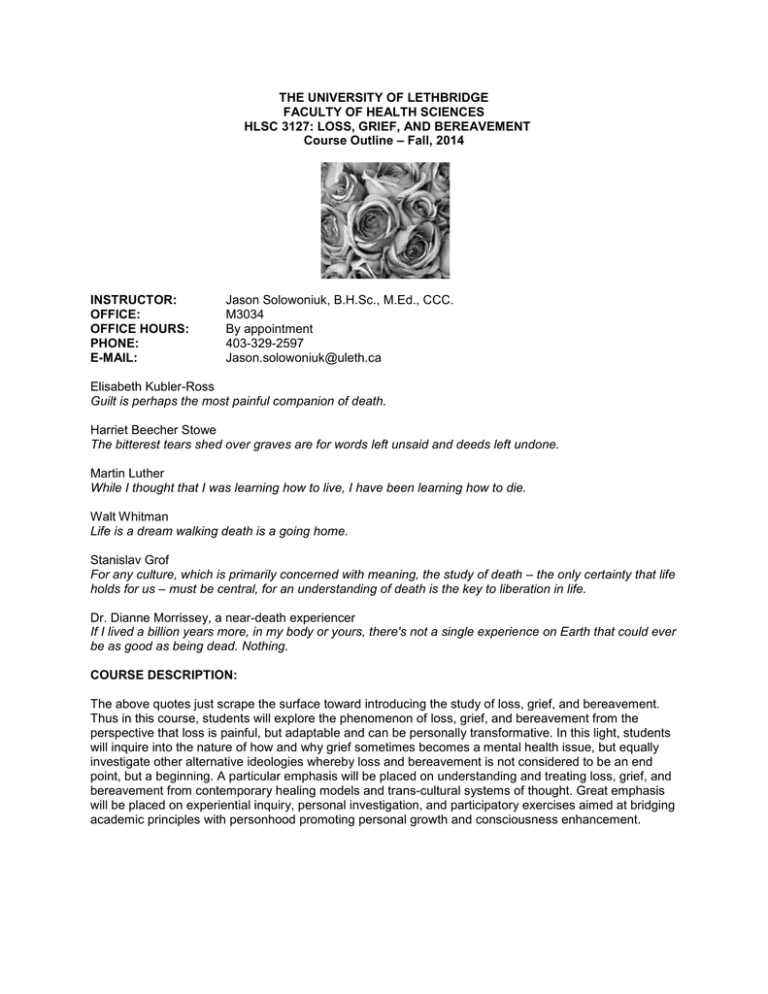
THE UNIVERSITY OF LETHBRIDGE FACULTY OF HEALTH SCIENCES HLSC 3127: LOSS, GRIEF, AND BEREAVEMENT Course Outline – Fall, 2014 INSTRUCTOR: OFFICE: OFFICE HOURS: PHONE: E-MAIL: Jason Solowoniuk, B.H.Sc., M.Ed., CCC. M3034 By appointment 403-329-2597 Jason.solowoniuk@uleth.ca Elisabeth Kubler-Ross Guilt is perhaps the most painful companion of death. Harriet Beecher Stowe The bitterest tears shed over graves are for words left unsaid and deeds left undone. Martin Luther While I thought that I was learning how to live, I have been learning how to die. Walt Whitman Life is a dream walking death is a going home. Stanislav Grof For any culture, which is primarily concerned with meaning, the study of death – the only certainty that life holds for us – must be central, for an understanding of death is the key to liberation in life. Dr. Dianne Morrissey, a near-death experiencer If I lived a billion years more, in my body or yours, there's not a single experience on Earth that could ever be as good as being dead. Nothing. COURSE DESCRIPTION: The above quotes just scrape the surface toward introducing the study of loss, grief, and bereavement. Thus in this course, students will explore the phenomenon of loss, grief, and bereavement from the perspective that loss is painful, but adaptable and can be personally transformative. In this light, students will inquire into the nature of how and why grief sometimes becomes a mental health issue, but equally investigate other alternative ideologies whereby loss and bereavement is not considered to be an end point, but a beginning. A particular emphasis will be placed on understanding and treating loss, grief, and bereavement from contemporary healing models and trans-cultural systems of thought. Great emphasis will be placed on experiential inquiry, personal investigation, and participatory exercises aimed at bridging academic principles with personhood promoting personal growth and consciousness enhancement. 2 COURSE GOALS/OBJECTIVES: At the completion of this course, students will be able to: Reflect on the sociocultural and historical roots of death, dying, grief and loss. Understand how individual, societal, and cultural attitudes towards death, grief, loss, and bereavement impact contemporary society. Describe contemporary treatment perspectives for populations suffering with losses and bereavements. Describe transcultural perspectives relating to death and dying (i.e., Near Death Experiences, Out of Body Experiences, Past Life Experiences). Integrate personal experiences of death, loss, grief and bereavement with knowledge, skills, and attitudes toward promoting understanding and sensitivity for those in professional and lay caregiver roles Reflect how death, dying, and loss can enhance one’s understanding of life. Identify and describe personal transformative aspects inherent to the phenomena of loss, grief, bereavement, and dying and how it can be consciousness enhancing. Instructional Methodology and Essential Learning Experiences: The course material will be presented using a combination of lectures, experiential based class activities, self-reflective exercises, and guest lectures. The emphasis is on student participation; self-reflection, exploration and sharing so that the theoretical concepts learned can be applied and integrated on a personal level. Course content and activities may evoke deep emotions. Students are encouraged to share their responses at the level to which they are comfortable. WHEN AND WHERE: The course is scheduled Tuesdays, from 4:30 p.m. to 7:15 p.m., in room AH175. REQUIRED TEXTS (Three required): Chopra, D. (2006). Life After Death: The Burden of Proof. New York: Random House. Humphrey, K. (2009). Counseling strategies for loss and grief. Alexandria, VA: American Counselling Association. Levine, S. (1984). Meetings at the Edge. New York: Anchor Press. ** In addition, mandatory PDF readings will also be posted online by the instructor (see schedule for titles and authors). 3 OVERALL GRADES: The grading system for this course is consistent with that established in the Faculty of Health Sciences, effective May, 2002: Grade A+ A AB+ B BC+ C CD+ D F Percentage 95 - 100 91 – 94.9 87 – 90.9 83 – 86.9 79 – 82.9 75 – 78.9 71 – 74.9 67 – 70.9 63 – 66.9 59 – 62.9 55 – 58.9 0 – 54.9 Grade Points 4.0 4.0 3.7 3.3 3.0 2.7 2.3 2.0 1.7 1.3 1.0 0.0 ASSIGNMENTS: 1) Journal Submission (1) 10% (See outline for due dates) Journal content and expectations will be discussed in class) 2) Journal Submission (2) 10% 3) Midterm Exam 30% Essay and multiple-choice 4) Take-Home Final 25% (To be discussed in class) 5) Participation 20% (Graded by student and Instructor) 6) Attendance 5% (to be discussed in class) Two field trips will take place throughout the semester; those who choose to not attend will be required to complete an essay or essays in their place. Essays will be due following the forthcoming class. PLAGIARISM STATEMENT: The University of Lethbridge subscribes to Turnitin.com, a plagiarism detection service. Please be advised that student work submitted for credit in this course may be submitted to this system to verify its originality. Students must be able to submit both electronic and hard copy versions of their work upon request. ACCOMMODATIONS FOR STUDENTS WITH A DISABILITY: Reasonable accommodations are available for students who have a documented disability. If you have been diagnosed with a disability, there is no need to face the challenge of University without support. Please contact the Accommodated Learning Centre at 329-2766 to set up an appointment http://www.uleth.ca/ross/counselling/index.html. After registering with the Accommodated Learning Centre, your instructor will be notified by a formal letter of any accommodations you require. In addition, students are responsible for requesting accommodations from the instructor at least *two weeks* in advance of the evaluation date. The instructor and student are jointly responsible for arranging the resources needed for the evaluation process. 4 Course Schedule (tentative and subject to change): Class # 1 Date Sept. 9 Topic(s) Instructor introduction, expectations, learning experiences. Student introductions (why taking course, major, etc.). Introduction to course. Required Reading/Assignments PDF Online: 1. As we think about death (Kastenbaum) 2. Opening Death’s Door (Gilbert) 3. Death and dying in contemporary society (O’Gorman) Selected weekly reading/writing for Journal from Meetings at the Edge 2 Sept. 16 Lecture 1: Opening Death’s Door and our attitudes toward death and dying Video Immersion: Crypts, Coffins, and Corpses 3 Sept. 23 Lecture 2: Attachment, Loss, and Bereavement – Part A PDF Online: 1. Attachment and Love (Parkes) 2. Handout and complete Attachment Questionnaire Selected weekly reading/writing for Journal from Meetings at the Edge Selected weekly reading/writing for Journal from Meetings at the Edge Video Immersion: Good Will Hunting 4 Sept. 30 Field Trip: Cornerstone Funeral Home & Crematorium PDF Online: 1. Finish reading Attachment and Love Selected weekly reading/writing for Journal from Meetings at the Edge Text: Chapters 9, 1, and 2 Lecture 3: Attachment, Loss, and Bereavement – Part B 5 Oct. 7 Guest Speaker (listening for Dawn’s attachment patterns and grief themes) 1. The Counselling Professional Working with Loss and Grief (Humphrey, K) 2. Thinking about Loss and Grief in the 21st Century (Humphrey, K) 3. Listening to and Listening for Loss and Grief Selected weekly reading/writing for Journal from Meetings at the Edge 6 7 Oct. 14 Oct. 21 Lecture 4: Thinking About Losses Diffferently in the 21st Century – Part A (Exploring complicated bereavement) Review Readings/Slides for Midterm Midterm Exam (Essay, Multiple Choice) Reading to be announced Journal 1 Due (6 Entries) Selected weekly reading/writing for Journal from Meetings at the Edge Selected weekly reading/writing for Journal from Meetings at the Edge 5 Class # Date Topic(s) Required Reading/Assignments Text: Finish Chapters 9, 1, and 2 8 Oct. 28 Exploring Loss, Grief, and Bereavement with Pet-Assisted Therapy and Art Two contemporary models of loss adaptation (Humphrey, Chapter 3) Selected weekly reading/writing for Journal from Meetings at the Edge 9 Nov. 4 Nov. 11 Lecture 5: Thinking About Losses Differently in the 21st Century – Part B Chopra – pages 1-100 (also for journal) Remembrance Day – No Class Lecture 6: Burden of Proof, Part A 10 Nov. 18 11 Nov. 25 Video: What Dreams May Come, Part 1 Lecture 7: Grief and Constructivist Theories Lecture 8: Burden of Proof, Part B 12 Dec. 2 Video: What Dreams May Come, Part 2 Journal 2 due (5 entries) Text: Chapter 4, pages 57-106. Chopra – pages 100-200 (also for journal) Finish reading Chopra Prepare for Take-Home Final Exam Hand Out Take-Home Final Due December 15 6 Journal Marking Matrix C+ Minimal Pass B Good AV. Good □ Appropriate # of journal entries is missing □ Appropriate # of journal entries □ Appropriate # of journal entries □ Appropriate # of journal entries □ Journal meets minimal knowledge level thinking □ Journal represents application level thinking □ Journal represents analysis level thinking □ Journal represents synthesis level thinking □ Logical flow of ideas is missing □ Somewhat logical expression of ideas presented from course material, but there are disconnected ideas and thoughts present throughout □ Clear, logical and meaningful expression of ideas and concepts linked to course content presented throughout most of the journal □ Logical connections between journal discussion and classroom material and self is clearly identified □ A self reflective process in journaling is missing □ Creative expression not present □ Self reflections in journals are often sparse □ Creative expression is minimal □ Journal self reflections are consistently presented and sometimes expanding on ideas / concepts presented in course material □ Creative expression is present, but does not enhance nature of the journal discussions as a whole. A Excellent □ Journal self reflections are consistently present and consist of reasoning and synthesis exceptionally expanding of ideas and concept presented in course material □ Creative expression enhances the nature of the journal discussion while promoting further thought and insights regarding course material □ Use of illustrative examples throughout journal represents exceptional depth and is presented in a succinct concise manner that expands the subject understudy.
